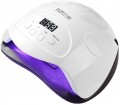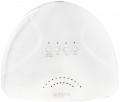Power
Rated lamp power; As a rule, it corresponds to the power of the lamps installed in it (or differs slightly from it). For combined models (see “Type”), in this case the total power of all light sources is taken into account; and for models with power control (see below) - the maximum value.
The higher the lamp power (all other things being equal), the faster the polymerization rate, the less time it takes for the coating to harden. In addition, the ability to work with certain compositions may depend on this parameter. Thus, for effective polymerization of colored materials, a lamp of at least 36 W is required. It makes sense to use less powerful devices only with transparent coatings; and very limited models - 12 W or less - are suitable only for minor corrections and fixing small decorative elements.
However, 36 W (and a little more) is still a relatively limited figure; Such devices should be seriously considered only in cases where they are purchased for infrequent use in the “at home, for yourself” format. A professional manicurist needs a lamp of at least 48 W, and preferably higher; in some devices this figure can even exceed 80 W. However, here it is worth considering that sometimes manufacturers use cunning, inflating the indicators - for example, indicating in the characteristics not the standard, but the peak power, which is achieved only at certain specific moments of operation. You should be especially careful if the figure of 80 W or more...is stated for a budget model; It wouldn’t hurt to clarify the real capabilities of such a lamp using reviews and testimonials.
Number of LEDs / lamps
The number of light sources largely determines the performance of a manicure lamp. If the drying chamber is capacious, in this case an increased number of emitters is used. Light sources are distributed evenly to create equally good illumination in all directions. The number of light sources depends on the type of lamp. If it is an LED emitter, 100 or more diodes can be used. But in some lamps, LEDs are combined into a single strip, in this case one common illuminator with many diodes is used.
As for CCFL manicure lamps, such devices usually use 1 common cold cathode spiral.
UV manicure lamps have the use of 3-5 fluorescent illuminators.
Timer
Variants of timer settings provided in the lamp design.
All manicure lamps use a timer to automatically turn off the light. This allows you to accurately adjust the session time, and also eliminates the need for the user to keep track of the time and turn off the device manually. And this paragraph indicates the settings options provided in the timer. The most popular standard timer values are
5s,
10s,
30s,
60s,
90s,
120s and
180s ; however, there are other options. Moreover, if the characteristics contain several values separated by a slash (for example, 30/60/90 s), this means that only these specific values are provided for the timer; other settings are not available for it. However, there is also a more advanced option, in the form of a whole range of adjustments - for example, “from 30 to 240 s.” In such a range, a certain adjustment step may be provided (for example, 5 or 10 s); however, even in such cases, the choice of timer settings is quite extensive, while more than 3 fixed values are rarely provided.
The choice for this parameter is quite obvious: you need to make sure that the timer settings best match the duration of the sessions that you plan to conduct using the lamp. And the duration of the sess
...ions, in turn, will depend on the type and power of the lamp itself, as well as on the materials used; Detailed recommendations on this matter, with descriptions of specific situations, can be found in special sources.Lamp life
Service life of the light source installed in the lamp. For combined models such as UV+LED and CCFL+LED (see “Lamp type”), this paragraph, as a rule, indicates the service life of all such sources - that is, the approximate operating time before failure of at least one of them.
In general, UV emitters have the shortest service life these days, but CCFL and LED lamps are much more durable. However, lamps of the same type can also differ markedly in this indicator. In such cases, you should assume that a more durable light source will cost more, but with intensive use, the long service life definitely outweighs the price difference. And vice versa: if you plan to use it infrequently (for example, a lamp is bought “at home, for yourself”), you should not specifically pursue models with a long service life.

